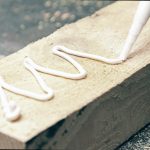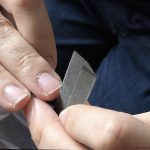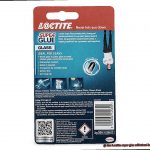Step into the captivating world of arts and crafts, where imagination knows no bounds. Amidst the array of crafting supplies, one adhesive stands out for its versatility and transformative abilities – Mod Podge. This remarkable substance has earned its place in the hearts of crafters worldwide, not just as a sealant but also as a powerful glue.
Brace yourself for an enlightening journey through the wonders of using Mod Podge as a glue, where ordinary materials are elevated to extraordinary works of art.
Understanding Mod Podge:
Contents
- 1 Understanding Mod Podge:
- 2 Why Mod Podge Makes an Excellent Glue:
- 3 Popular Uses of Mod Podge as a Glue:
- 4 Can Mod Podge be used as a Glue?
- 5 How Does Mod Podge Compare to Regular Glue?
- 6 What Types of Materials are Suitable for Mod Podge?
- 7 When Should You Not Use Mod Podge as a Glue?
- 8 Tips for Using Mod Podge as a Glue Substitute
- 9 Alternatives to Mod Podge for Heavy-Duty Bonding
- 10 Conclusion
At its core, Mod Podge is more than just your average glue. Crafted from a water-based formula, it possesses the unique ability to act both as an adhesive and a sealer.
Its adhesive properties enable it to bond various materials together seamlessly, while its sealing qualities provide a protective finish that preserves your magnificent creations.
Why Mod Podge Makes an Excellent Glue:
- Versatility: Prepare to be amazed by Mod Podge’s boundless potential. It effortlessly adheres to surfaces such as paper, fabric, wood, plastic, glass – you name it. Whether you’re embarking on a scrapbooking adventure or creating mesmerizing mixed media art, Mod Podge is your ultimate adhesive companion.
- Strength and Durability: When it comes to holding materials firmly in place, Mod Podge reigns supreme. Once dry, it forms an unyielding bond that withstands the test of time, shielding your masterpieces from wear and tear.
- Ease of Use: Crafting should be a joyful experience for everyone involved – from beginners to seasoned artisans. With its user-friendly nature and perfect consistency, Mod Podge caters to all skill levels. Smooth and controlled applications are guaranteed while ensuring no unsightly residue mars your artistic endeavors.
- Additional Effects: Prepare to take your creations to new heights with Mod Podge’s enchanting versatility. This remarkable adhesive can be mixed with pigments, glitters, or other decorative elements, adding a touch of captivating sparkle or texture to your projects.

Popular Uses of Mod Podge as a Glue:
If you’re searching for a product that can do it all – glue, seal, and finish – then Mod Podge is about to become your new obsession. This wonderous creation has been captivating artists and crafters for decades with its unique properties and limitless creative possibilities. So, let’s dive into the world of Mod Podge and discover how it can transform your crafting dreams into reality.
What is Mod Podge?
Mod Podge is more than just a glue; it’s a water-based adhesive that combines polyvinyl acetate (PVA) glue with a touch of magic. This versatile crafting essential bonds materials together, but its capabilities extend far beyond that. With its clear drying formula and an array of finishes including matte, gloss, satin, and sparkle, Mod Podge allows you to customize the look and feel of your projects in ways that traditional glues simply cannot.
Versatility at Its Finest:
Prepare to have your creative horizons expanded. Mod Podge can adhere to an astonishing range of surfaces, from paper and fabric to wood, glass, ceramic, and even metal. Whether you’re designing personalized home decor, adding flair to scrapbook pages, or fashioning one-of-a-kind jewelry pieces, Mod Podge has got you covered. This miraculous adhesive works its magic on virtually any material you can dream of.
The Power of Preservation:
Not only does Mod Podge bond materials together; it also acts as a protective sealant. Applying Mod Podge over your finished project creates a shield against moisture, dust, and the wear and tear of time. This makes it the ideal choice for preserving and safeguarding cherished artwork or crafts that are meant to be treasured for years to come.
To achieve extraordinary results with Mod Podge, here are some indispensable tips:
- Follow the instructions: Different types of Mod Podge may have specific guidelines for application and drying time. Be sure to read and follow the manufacturer’s instructions to achieve optimal results.
- Multiple coats: Depending on your project and desired outcome, applying multiple coats of Mod Podge may be necessary. This will enhance the durability and finish of your creation, taking it to the next level of craftsmanship.
- Experiment with finishes: Dive into a world of finishes. Mod Podge offers a variety of finishes to suit your artistic vision. Whether you prefer a subtle satin sheen or a striking glossy look, don’t be afraid to experiment and find the perfect finish for your masterpiece.
Can Mod Podge be used as a Glue?
Step into the enchanting realm of Mod Podge, where crafting dreams come to life. If you’re a creative soul, you’ve likely heard whispers of its mystical powers. But can this all-in-one adhesive truly work its magic as a glue substitute for various projects? Let’s embark on a journey to explore the possibilities and uncover the secrets of Mod Podge.
Decoupage Delight: The Queen of Adhesion
When it comes to decoupage, Mod Podge reigns supreme. Its unparalleled ability to adhere paper and fabric to surfaces like wood, glass, and plastic is nothing short of magical. With a strong bond and flawless finish, Mod Podge guarantees that your decoupage creations will stand the test of time.
Versatility Conundrum: A Match Made in Crafting Heaven, with Exceptions
While Mod Podge shines in the decoupage realm, its effectiveness as a general-purpose adhesive may vary. Lightweight and porous materials such as paper or fabric are a match made in crafting heaven for Mod Podge. However, for heavier or non-porous materials like metal or plastic, you may need to summon another glue from your crafting toolbox.
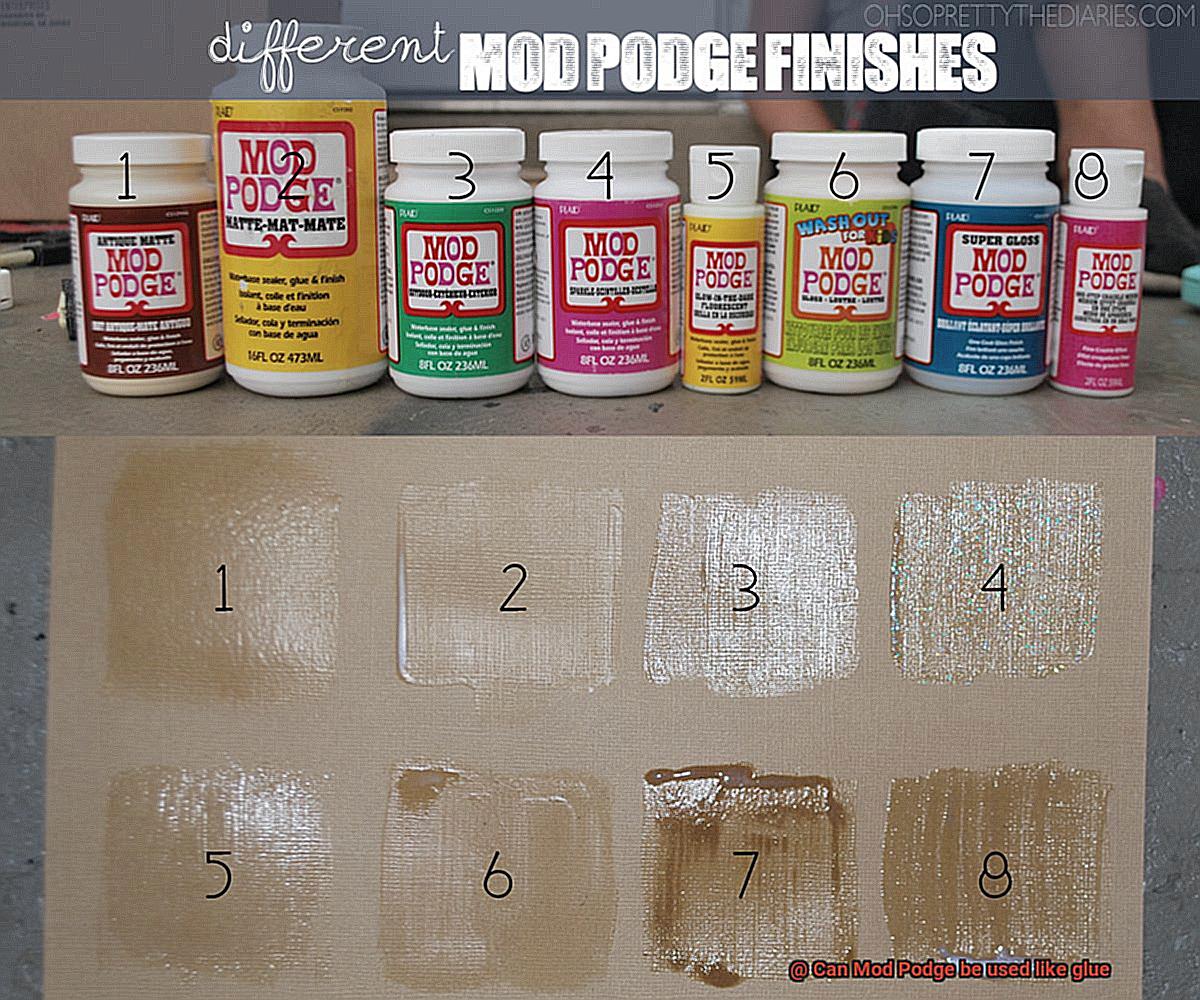
Time is of the Essence: Patience in the Realm of Mod Podge
Are you in a hurry to complete your masterpiece? Think twice before calling upon Mod Podge. Its drying time of 15-20 minutes (to the touch) and 24 hours (complete cure) may not align with your need for instant bonding or quick results. Patience is key in the realm of Mod Podge, where great things come to those who wait.
Beware of Tacky Temptations: Texture Matters
A slight tackiness may linger even after Mod Podge has dried, which can be a blessing or a curse depending on your project. For decoupage enthusiasts, fear not. Additional layers of Mod Podge or varnish will transform that tacky finish into a smooth and glossy masterpiece. However, for other crafts, it’s essential to consider the desired texture and finish.
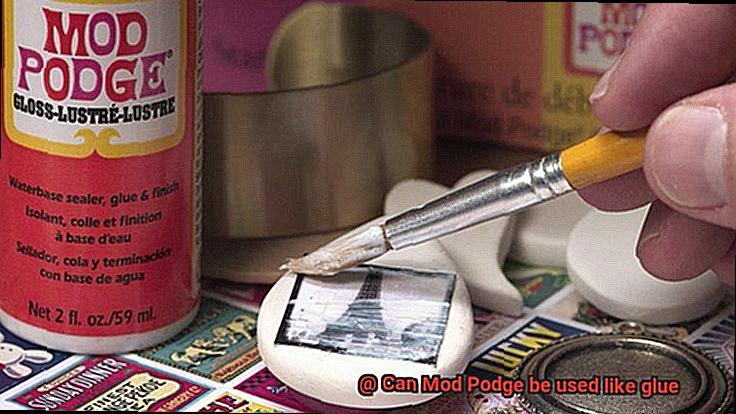
The Importance of Testing: Tread Cautiously into the Unknown
When venturing into uncharted crafting territory, it’s wise to tread cautiously. Before entrusting Mod Podge with your project, perform a small-scale test on an inconspicuous area. This will reveal its adhesion strength and compatibility with the materials you’re working with, ensuring a harmonious union and preventing any crafty mishaps.
How Does Mod Podge Compare to Regular Glue?
Mod Podge and regular glue may seem similar at first glance, but there are distinct differences that make Mod Podge stand out as a crafting superstar.
Let’s start with consistency. Regular glue is often liquid or gel-like, while Mod Podge has a thicker, paste-like texture. This means Mod Podge spreads smoothly and evenly, reducing the risk of messy drips or runs.
Drying time is another key factor. Regular glue can take its sweet time to dry, leaving you waiting around for your project to be complete. On the other hand, Mod Podge dries relatively quickly, perfect for those of us who are impatient or have time-sensitive projects.
Now, let’s talk about the finish. Mod Podge is famous for its smooth, glossy finish that adds an extra touch of pizzazz to your crafts. Regular glue may leave a more matte or textured finish, depending on your preference.
When it comes to sticking different materials together, both Mod Podge and regular glue have their strengths. Regular glue is suitable for basic paper-to-paper or fabric-to-fabric bonding. But Mod Podge? It can handle it all. Paper, fabric, wood, plastic – you name it, Mod Podge can stick it together.
Durability is another area where Mod Podge shines. Once dried, it forms a strong bond that can withstand wear and tear. Regular glue may not offer the same level of durability, especially on porous or delicate materials. If you want your masterpiece to last, Mod Podge is the way to go.
And here’s a secret: Mod Podge comes in different formulas. There’s one for outdoor use, one for fabric projects, and even one that’s dishwasher-safe. Talk about versatility.
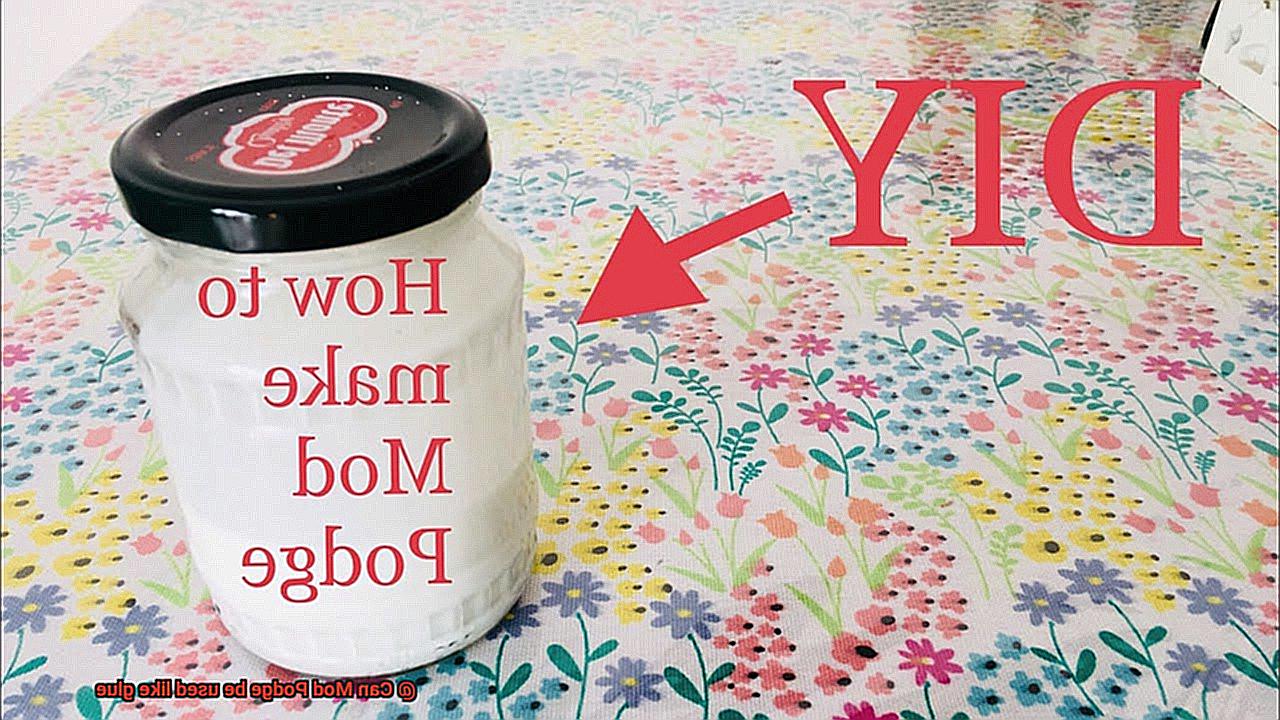
What Types of Materials are Suitable for Mod Podge?
This versatile crafting medium is a must-have for any craft lover. Whether you’re working with paper, fabric, wood, glass, ceramics, or even plastic and metal, Mod Podge has got you covered. Let’s dive into the exciting world of Mod Podge and discover what makes it the ideal adhesive for all your crafting adventures.
Paper Magic:
Mod Podge and paper are a match made in crafting heaven. Mod Podge works wonders when it comes to adhering paper to various surfaces. Whether you’re creating stunning decoupage designs or scrapbooking memories, Mod Podge ensures a strong bond without wrinkling or warping your precious paper creations. It creates a smooth and even finish that will make your crafts shine, whether you’re sticking paper to wood, glass, or fabric.
Fantastic Fabrics:
If you’re into sewing or fabric crafts, Mod Podge is your new best friend. It works like magic when adhering fabric to fabric or fabric to other surfaces like wood or canvas. Just make sure to choose the right formula for fabric projects to enjoy a durable and washable finish that will stand the test of time. Mod Podge allows you to create stunning fabric-covered furniture, accessories, and personalized gifts that will leave everyone in awe of your crafting skills.
Wood Wonder:
Woodworking enthusiasts rejoice. Mod Podge is perfect for sealing and protecting unfinished wood surfaces. It also excels at adhering paper or fabric to wooden surfaces, allowing you to create unique decoupage designs on everything from small jewelry boxes to larger furniture pieces. With Mod Podge, you can transform plain wooden objects into personalized works of art that showcase your creativity and style.
Glass Glamour:
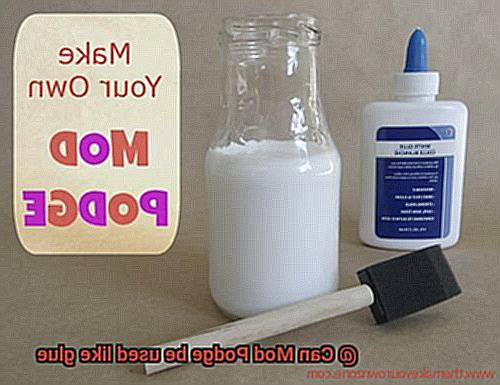
Transform plain glass into works of art with Mod Podge. Use it to adhere paper or fabric onto glass surfaces, turning ordinary jars, vases, or plates into eye-catching decor pieces. Mod Podge provides a strong bond on glass, creating a seamless finish that enhances the design and protects it from wear and tear. Additionally, Mod Podge can act as a sealant on painted ceramics, prolonging their lifespan and preventing chips and fading.
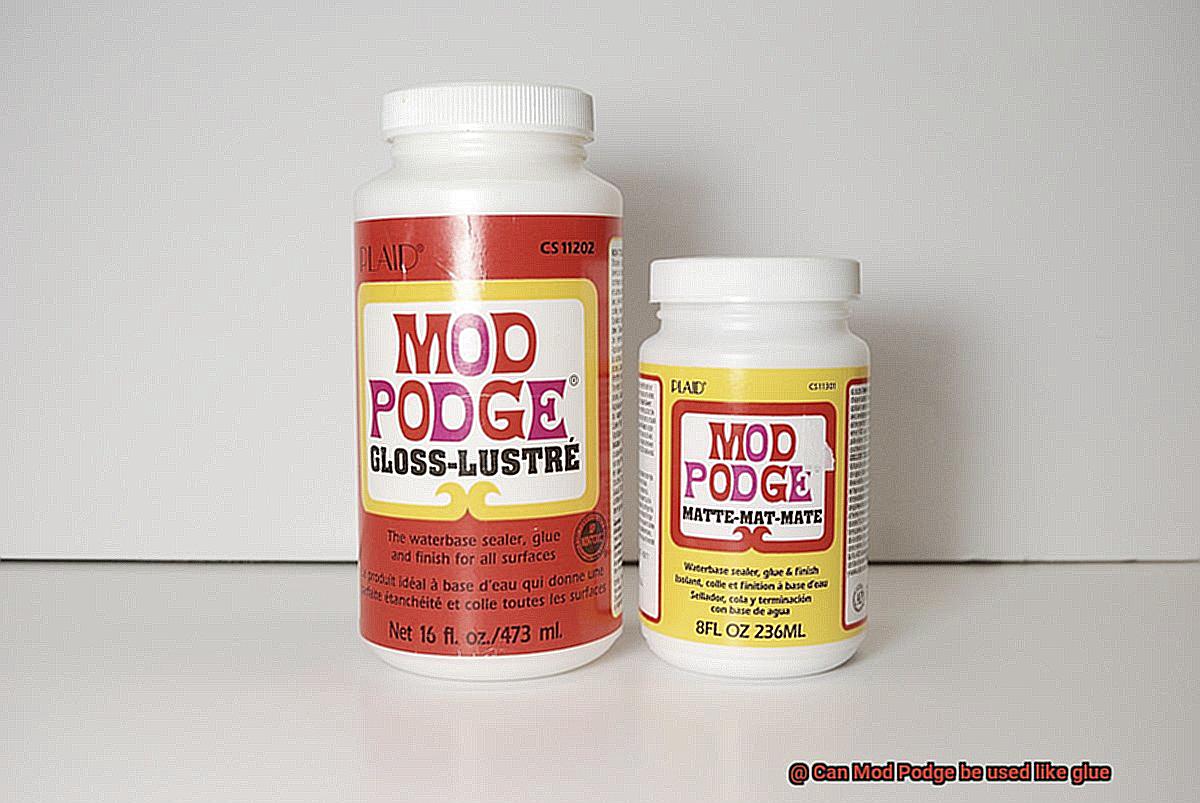
Plastic Possibilities:
While Mod Podge can work on lightweight plastics like acrylic or thin plastic sheets, it’s best to test it on a small area before applying it to larger plastic surfaces. Some plastics may not provide a strong bond, but Mod Podge can still be used creatively to add a protective layer or embellishments to your plastic projects.
So, whether you’re upcycling plastic containers or creating unique accessories, Mod Podge can add that extra touch of creativity and durability.
When Should You Not Use Mod Podge as a Glue?
Mod Podge is like the superhero of crafting adhesives, but even superheroes have their limitations. So, when should you not use Mod Podge as a glue? Let’s dive into some situations where this beloved adhesive may not be the best choice.
- Heavy-duty projects: If you’re working on a project that involves heavy or load-bearing objects, it’s time to put Mod Podge aside. While it’s great for lighter materials, Mod Podge may not provide the strength and durability needed for heavier items. In these cases, opt for a stronger adhesive specifically designed for heavy-duty projects.
- Materials prone to warping: Mod Podge contains water, and water and certain materials just don’t mix well. Thin paper or delicate fabrics are more likely to wrinkle or distort when exposed to moisture. So, if you’re working with these materials, it’s best to skip the Mod Podge and look for a glue that won’t cause unwanted warping.
- Outdoor projects: Planning on creating something to withstand the elements? Mod Podge might not be your go-to glue for outdoor projects. While it’s water-resistant when dry, it’s not fully waterproof and may not hold up well under rain, sun, or humidity. For projects that will brave the great outdoors, choose an adhesive specifically formulated for outdoor use.
- Items requiring frequent handling or washing: Mod Podge provides a strong bond initially, but repeated use or washing can weaken the bond over time. If you’re gluing items that will undergo regular wear and tear or require washing, it’s best to choose an adhesive meant for such applications to ensure longevity.
- Matte finish preference: Mod Podge can leave a visible sheen or gloss on certain surfaces. If you prefer a more matte or natural-looking finish for your project, using Mod Podge as a glue may not be your best bet. Look for other adhesive options that provide the desired finish you’re after.
- High-temperature environments: Mod Podge is not heat resistant and may soften or melt under high temperatures. If you’re working on a project that will be exposed to heat, such as near a fireplace or oven, it’s important to choose an adhesive that can withstand those conditions.
- Long-term preservation: If you’re looking to preserve an item for many years, such as photos or important documents, Mod Podge may not be the best choice. Over time, Mod Podge can yellow or become brittle, potentially damaging the item you’re trying to preserve. In these cases, consider using archival-quality adhesives specifically designed for long-term preservation.
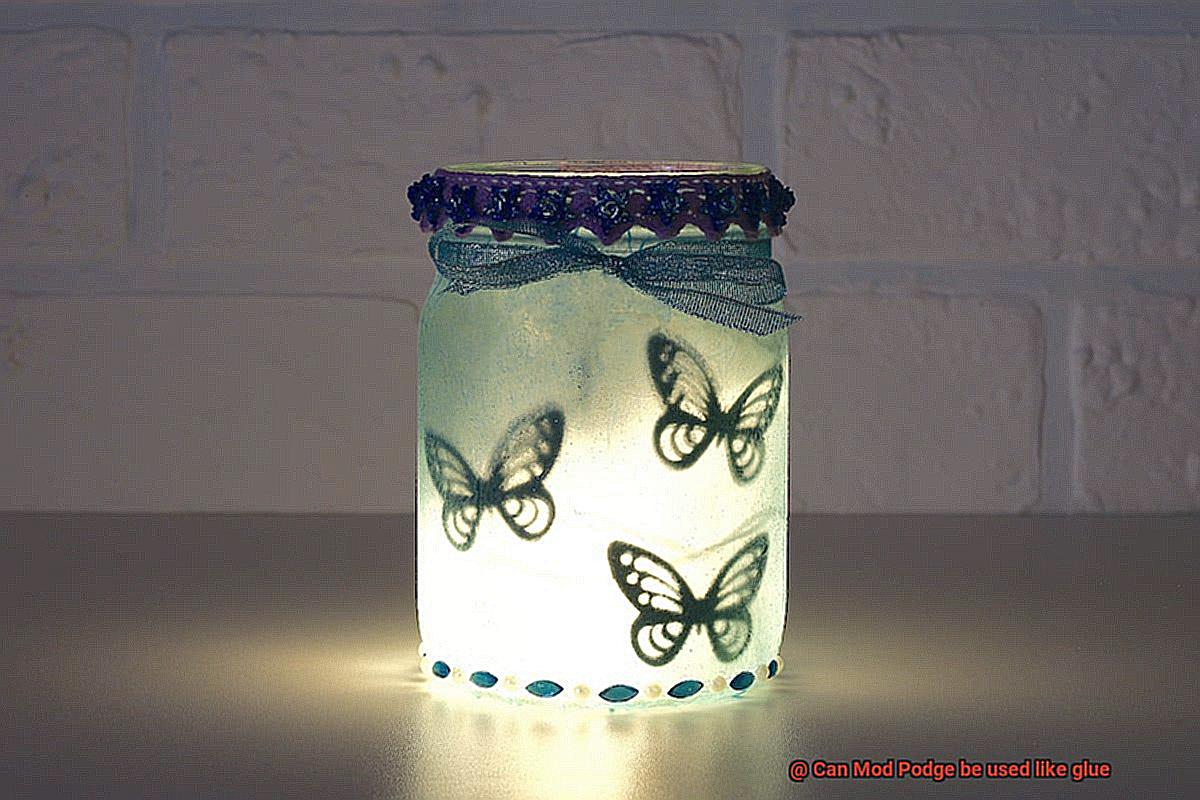
Tips for Using Mod Podge as a Glue Substitute
If you’re searching for a versatile adhesive to use in your crafting projects, look no further than Mod Podge. While not technically a glue, Mod Podge can be an excellent substitute in many situations. In this blog post, we will explore some useful tips for using Mod Podge as a glue substitute and provide insights into its benefits and limitations.
Apply it Sparingly:
Mod Podge has a thick consistency, so remember that a little goes a long way. Start with a small amount and add more if needed. Applying it sparingly will prevent excess glue and clumps that could spoil your project.
Whether you’re adhering paper, fabric, or other materials, using Mod Podge sparingly will ensure a clean and professional finish.
Use an Applicator:
To ensure even application, use a brush or sponge applicator when spreading Mod Podge. This will allow you to cover the surface smoothly and avoid uneven adhesion. A brush with soft bristles or a foam sponge applicator is ideal for delicate projects like decoupage, as it prevents tearing or wrinkling of the materials.
Allow Ample Drying Time:
After applying Mod Podge, be patient and let it dry completely before handling or moving your project. Depending on the thickness of the application and the humidity of your environment, drying time can range from a few hours to 24 hours. Rushing the drying process may result in smudging or damage to your work. To speed up the drying time, consider placing your project in a well-ventilated area with low humidity.
Test Compatibility:
Before using Mod Podge on a new surface, it’s essential to test its compatibility. Apply a small amount to an inconspicuous area and check if it damages or warps the material. This step ensures that you achieve the desired outcome without any unwanted surprises. It’s especially important to test Mod Podge on delicate or porous materials like silk or untreated wood.
Consider Sealing Porous Materials:
When working with porous materials like fabric or wood, consider sealing the surface first with a coat of Mod Podge. This will prevent excessive absorption of the adhesive, resulting in better adhesion and a neater finish. Applying a thin layer of Mod Podge as a sealer will also help protect the material from moisture or damage.
Alternatives to Mod Podge for Heavy-Duty Bonding
Look no further than these alternatives to Mod Podge for heavy-duty bonding. These options will provide the durability and strength you need for construction projects, woodworking, or any craft that requires a strong bond.
- Epoxy Resin: This two-part adhesive is a powerhouse when it comes to heavy-duty bonding. When the resin and hardener are mixed together, they create a strong and durable bond that can withstand heavy loads and resist moisture. Epoxy resin is commonly used in construction, woodworking, and automotive applications due to its exceptional strength.
- Cyanoacrylate Adhesive (Super Glue): Known for its fast bonding and incredible adhesion properties, super glue is perfect for non-porous surfaces like metal, plastic, and glass. It forms an instant bond that can handle heavy-duty tasks. However, it may not be suitable for porous materials like fabric or paper.
- Polyurethane Adhesive: If you need an adhesive that can bond almost anything, polyurethane adhesive is the way to go. It can bond a wide range of materials such as wood, metal, glass, and plastic. Polyurethane adhesive forms a strong bond that can withstand extreme temperatures and moisture. Its flexibility also allows for some movement or expansion in applications where required.
- Fabric Glue: When working with fabrics or needing flexibility in your bond, fabric glue is a top choice. It is specifically formulated for bonding fabric to fabric or fabric to other materials. Fabric glue provides a strong bond while remaining flexible, allowing the bonded materials to move without compromising the adhesive.
- Contact Cement: When it comes to instant bonding and high strength, contact cement is unbeatable. This adhesive is applied to both surfaces being bonded and allowed to dry before joining them together. Contact cement forms a strong bond that is resistant to heat, water, and most chemicals. It is commonly used in woodworking and construction projects where heavy-duty bonding is required.
Consider the materials being bonded, the desired strength of the bond, and the environmental conditions when choosing an alternative adhesive. Always read and follow the manufacturer’s instructions for proper application and safety precautions. Test the adhesive on a small area before applying it to your entire project to ensure compatibility and desired results.
Cwoi5CEQ9IU” >
Conclusion
Mod Podge is a versatile crafting product that can indeed be used as a glue substitute. Its adhesive properties make it suitable for a wide range of projects, from paper crafts to decoupage and more. With its smooth consistency, Mod Podge adheres well to various surfaces, providing a strong bond that holds your creations together.
Whether you’re working with fabric, wood, glass, or even plastic, Mod Podge can be relied upon to secure your materials firmly in place. It dries clear and creates a seal that protects your artwork from moisture and wear, ensuring its longevity.
Not only does Mod Podge function as an effective adhesive, but it also offers additional benefits. It acts as a sealer and finisher, adding a glossy or matte sheen to your projects depending on the variant you choose. This dual functionality saves time and effort by eliminating the need for multiple products.
Crafters appreciate the ease of use that Mod Podge provides. Its water-based formula makes cleanup simple with just soap and water. Additionally, its non-toxic nature ensures safety during application, making it suitable for all ages.


